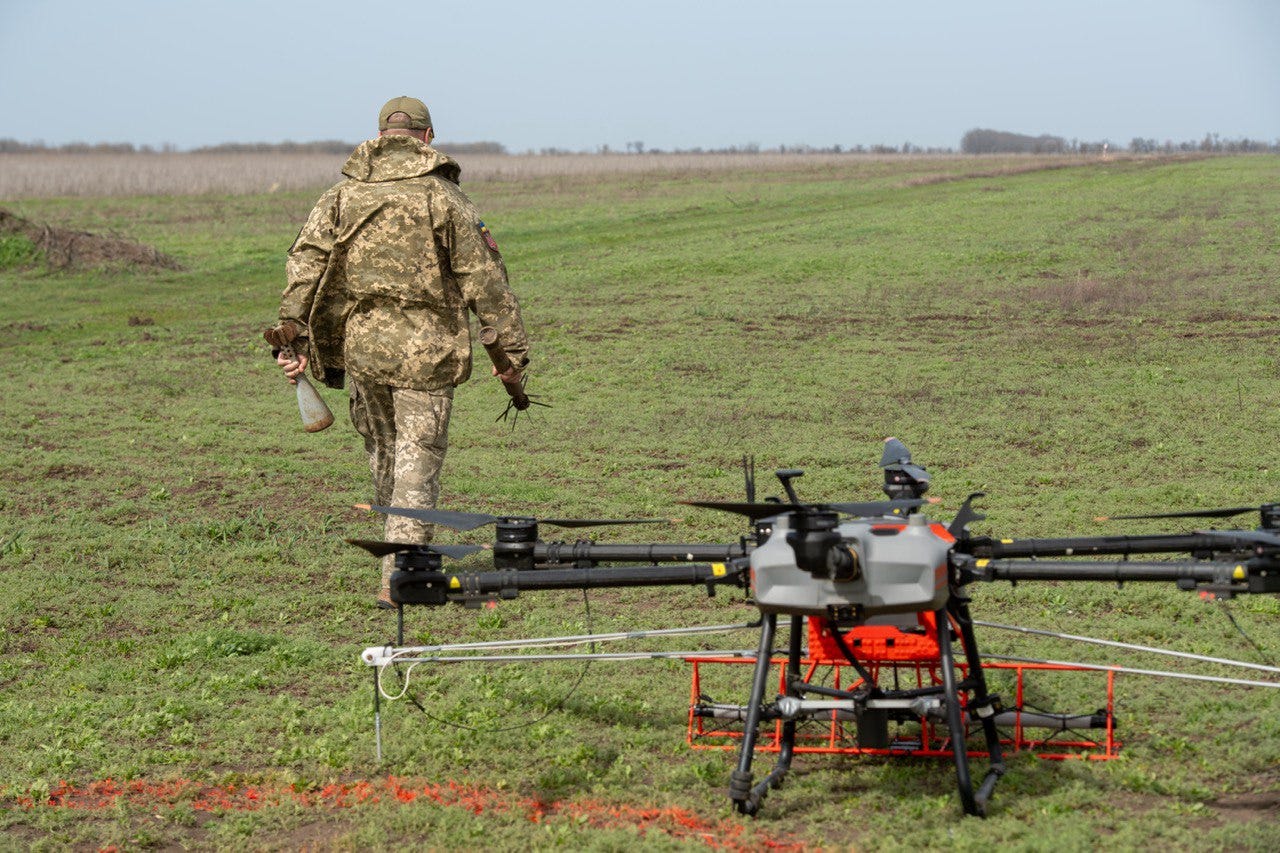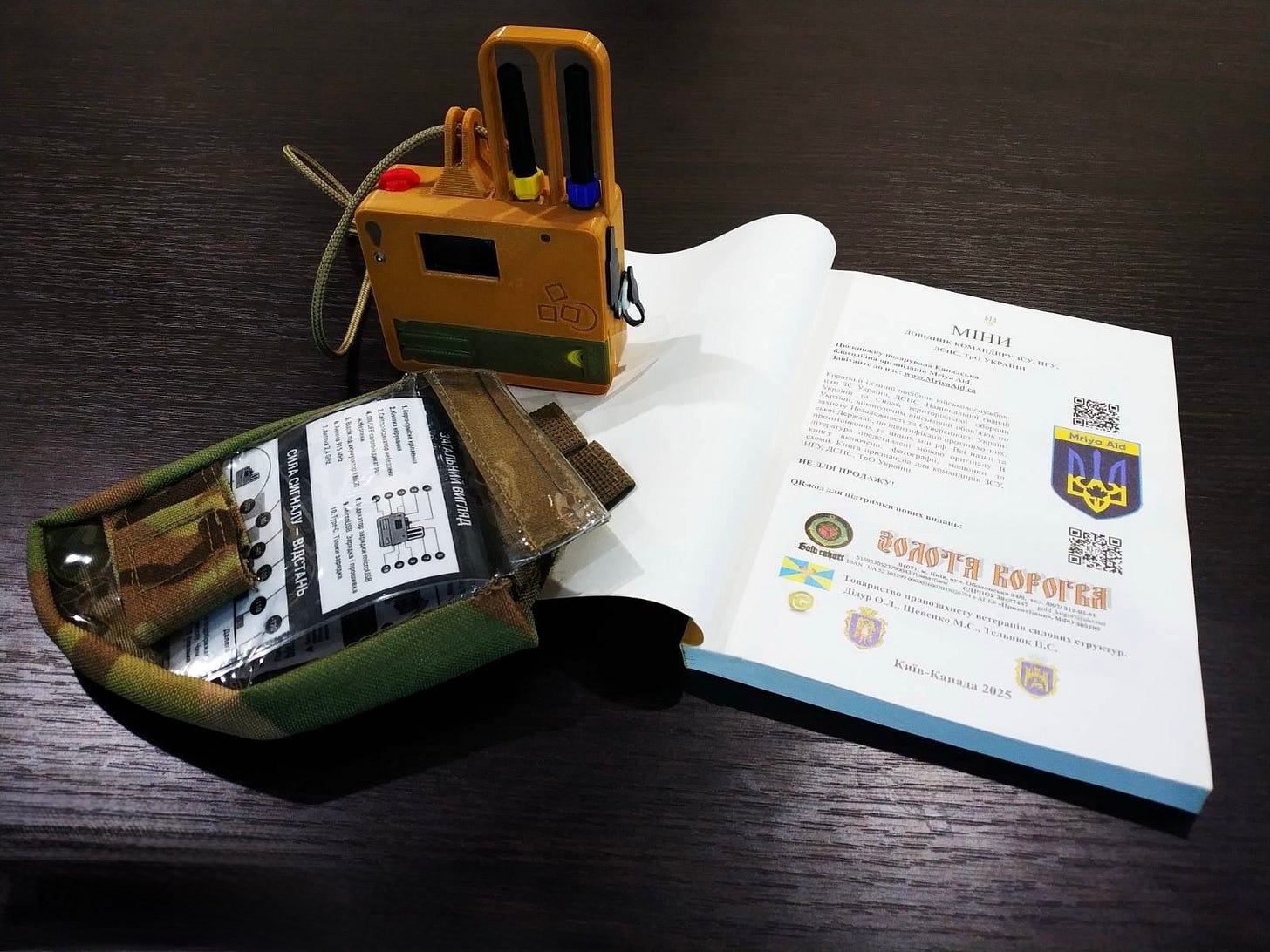Eyes and Ears on the Battlefield
How affordable drone detectors help Ukrainian sappers and defenders stay alive and why Mriya Aid raises funds for these life-saving devices
On the front lines of Russia’s war against Ukraine, even silence can be deadly. It is in those quiet moments that danger often arrives: fast, unseen, and devastatingly accurate. Kamikaze drones, guided by operators tens of kilometres away, now hunt not only equipment but also soldiers and sappers themselves. These attacks are called “dumps” or “drops”, where the enemy drone drops ammunition and explosives on sappers, soldiers or even civilians, as Russians do regularly in their criminal “human safaris” in Kherson and other frontline areas.
Ukraine’s sappers, the engineers tasked with clearing landmines and unexploded ordnance to make way for logistics or to secure liberated territory, are often the first to enter an area, operating in open fields with no cover.
“Sappers are one of the primary targets for FPV-drones, first-person-view models equipped with explosives, flown manually by enemy operators,” says Serhii Bilevych, commander of the engineering and sapper unit at Ukraine’s 8th Training Centre of the State Special Transport Service (SSTS). “They work where no one else can.”
In such hostile conditions, the chance to detect a drone even a few seconds earlier can mean the difference between life and death. That is why Ukrainian sappers use drone detectors, small handheld electronic reconnaissance devices that pick up signals of approaching UAVs long before they become visible or audible to the human ear.
“These detectors give us a chance to react, to stop, to take cover, even to activate electronic countermeasures if we have them nearby,” Bilevych explains. “They are our extra eyes and ears. We don’t see them as gadgets. We see them as life-saving tools.”
Earlier this year, one of his fellow commanders was killed by a Russian FPV drone. “One detector can protect not just a soldier but an entire crew,” he says.
Thanks to donor support, in June Mriya Aid delivered 100 drone detectors called Tsukorok (“Candy”) to frontline AFU sapper teams. The generosity of each donor who contributed to the fundraising campaign that ran from April 28 to late June is being acknowledged by a certificate of appreciation from Mriya Aid.
We want our donors and friends to know that their donations result in actual lives saved, and that this support for Ukrainian sappers is deeply appreciated.
Each life-saving unit costs just over $100 USD - a small sum for the incredible value of protecting lives!
In November 2024, Mriya Aid delivered 80 of these devices to Armed Forces of Ukraine and National Guard sapper teams. In June, we delivered another 100 thanks to our first fundraising campaign, and currently, we’re launching a second campaign to purchase 30 devices for SSTS sapper units. Please help us improve sapper and deminer safety and survivability!
We bought one of the most widely used and affordable models, nicknamed Tsukorok, meaning “Candy” or “Sugar Cube”. It is a compact passive drone detector developed by Dmytro Selin, a Ukrainian IT engineer, who said that when he went to look for available casings while designing the detector, the best option was a small plastic sugar container. Mriya Aid purchased them from a local Ukrainian manufacturer, who we visited in Ukraine earlier this year to discuss key tools that sappers need today.
Originally from Dnipro, Selin began designing the device in his home workshop after Russia’s full-scale invasion in 2022. Drawing on his background in radio technologies, he built a pocket-sized detector that picks up a range of different UAV signals up to 10 miles away. For over a year, there have constantly been waiting lists to purchase these Tsukoroks. Mriya Aid is lucky to have a local Ukrainian supplier who ensures not only availability, but safe and reliable delivery and distribution.
These drone detection devices are passive - they emit no signal, thereby reducing the risk of detection, and alert users through vibration and a loud beep when a drone is nearby. It is much smaller and easier to use than more complex units - some costing well over $1M. The portable devices capture signals from all types of small drones used by Russians - and are designed to lock onto the changing frequencies of signals Russians program to evade detection or jamming by electronic warfare.
The realities on the ground have become more complex since the “Tsukorok” was invented and mass produced. Russians send hundreds of fibre optic drones each day that don’t emit an electronic signal, but Ukrainians on the frontlines shoot down the fibre optic drones and rely on drone detectors to alert them of the thousands of FPV and other detectable drones sent each day. While the fibre optic drones fly lower to the ground, they typically rely on reconnaissance FPV drones flying at a higher altitude and emitting a signal. Drone detectors warn sappers that they are being observed and that they should take measures against the killer kamikaze drones coming in swiftly soon afterwards.
For sappers, who work in silence and under intense concentration, the pocket drone detection device is reliable and essential.
Today, more than 50,000 Tsukoroks are in use across Ukraine’s frontlines. Their users range from engineers to medics, drivers, and artillery detachments. Sappers and sapper units value them tremendously, as each small and personal or pocket-sized detector is shared by a team and is passed to the next team as sappers are rotated out.
Although our 180 detectors represent less than 1% of the devices at the frontlines, the impact of this support is great: the more sappers and soldiers we save today, the more civilians they can save immediately and in the future by surviving in the field and removing mines and explosive ordnance from the ground.
For sappers, the detectors offer the gift of time - a precious and life-saving commodity in war. When the sky turns quiet and every second counts, that simple beep might be the thing that saves their lives.
Mriya Aid is continuing its fundraising efforts to supply 30 more of these detectors to the sapper units who need them most. If you would like to help, your donation could provide a tool that protects those who risk everything to make Ukraine’s land safe again.
Please visit our website to donate, and join us in supporting Ukraine on LinkedIn, Facebook and X.





